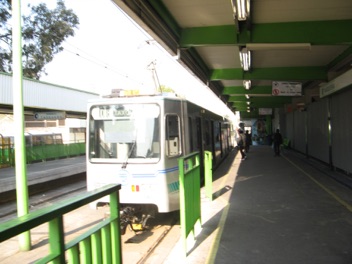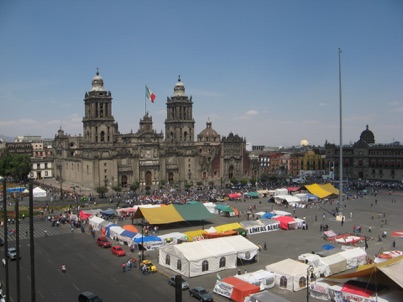“No, we only have 200 pesos,” Meredith said in Spanish as she stood up to leave, and, me understanding from her motions what she was saying, I stood up also.
The older gentlemen gave a pained look that seemed to say, “Shit, I thought I could bluff that little gringa better than this.”
He and Meredith did the haggle doe-see-doe for a few more seconds. She then turned to me and explained we would get a 90 minute tour for the prescribed 200 pesos.
“Well, that’s good, cause that’s all the cash we have left,” I said as I sat back down.
In several areas of the Valley, there are still canals and boats are used as transportation between artificial islands. Xochimilco is one of these places.
Our guidebook, once again, was excellent and had explained to us that the Metro didn’t go all the way out to the suburb, but we could take a line to its terminus and then transfer to a light rail train that would take us to the center of the town.
Immediately after exiting the light rail station an older gentlemen pedaled up to us on a bicycle and pointed along the street we were walking. He knew what we were looking for and we knew he knew what we were looking for. To say people could read our intentions was an understatement.
After the aforementioned song and dance over the price, the nice man found us a boat that was still usable, and a captain that would provide our forward progress with a long pole.
I’ve said it before, but I’ll say it again. We, in America, have no style. The world is colorful place, and in Mexico, if the world isn’t colorful enough, a bit of paint can always be added to spice things up just a bit.
Our guide poled us out into the main canal and we had a leisurely float, sometimes looking at peoples back yard’s, sometimes looking at greenhouses with many hundreds of plants, many of which we’d never seen before.
We floated and enjoyed the morning.
After about an hour, we returned to the docks and headed back north, to the city center.
We dressed and took the elevator to the top floor.
The restaurant is situated so that one side faces the Zocalo and we coincidentally arrived at the same time the huge Electrical Workers Union began its march through downtown. We walked onto the balcony and got a bird’s eye view of the crowd.
Apparently, things like that aren’t everyday occurrences. I looked up to see several of the staff of the restaurant staring at the crowd too.
We sat down, had a great meal and enjoyed the rest of the afternoon.
















